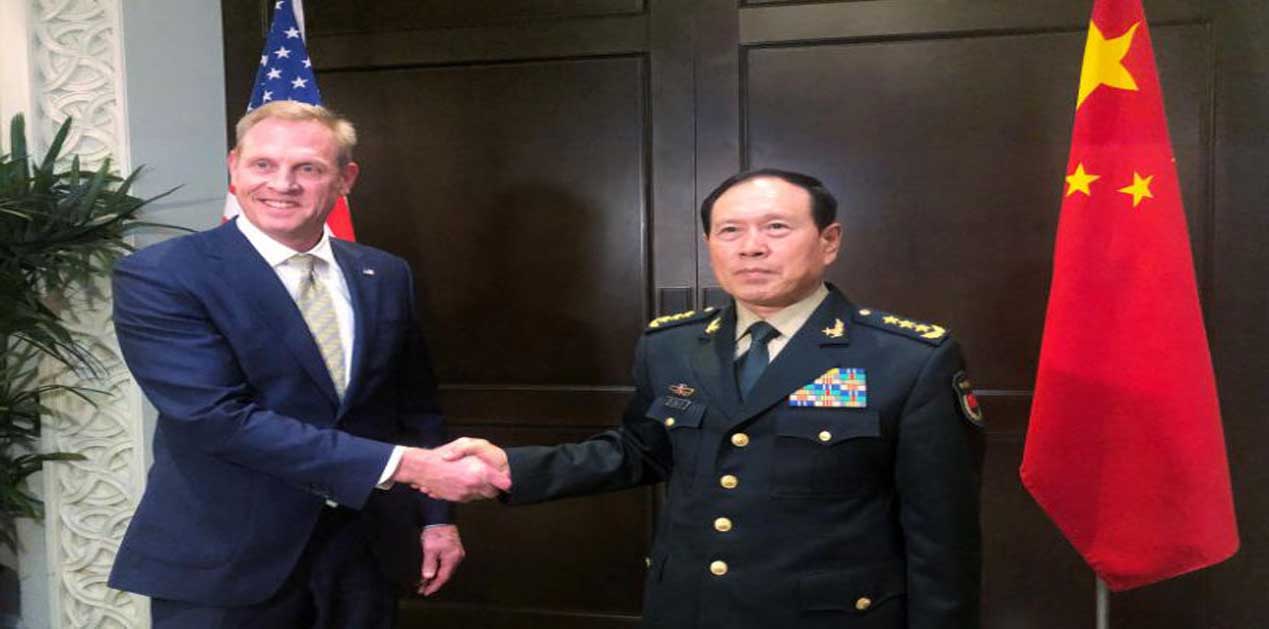Recalling Queen Victoria’s diamond Jubilee in 1897, Arnold Toynbee had remarked, “Here we are at the top of the world. We have arrived at this peak to stay forever. There is off course, this thing called history”. At the Shangri-La Dialogue (SLD)-2019 on June 01-02, 2019, both the U.S. and China seemed unmindful of Toynbee’s caution and of the bigger issues that face the world today. On the one hand, the Chinese General Wei Fenghes tried to convince the world with his unctuous eloquence about China’s innocent intent. On the other, the U.S. Acting Secretary of Defence Patrick Shanahan heaped all the recriminations on China for raising the security dilemma in the Indo-Pacific.
The SLD-2019 sounded like an alarm bell for self-effacing nations along the edge of the Indo-Pacific. It is time to brace for the approaching eddies of the great game into which all are being unwitting sucked. So, the disparate visions unfurled by the major players at the SLD-2019 need deliberation before arriving at plausible security policies for India.
The U.S. Vision of Liberal Hegemony
The U.S. perceives itself as a stabilising influence in the Indo-Pacific, without which the region’s prosperity would be under jeopardy. However, it ignores the fact that the region was prosperous even before its western colonisation and much before the U.S. even existed. So, one is tempted to view the altruistic claims of the U.S. with some circumspection. Notwithstanding, there is no denying that the U.S’ initiatives under the watch of President Trump has once again revived the hopes of its allies and partners for being able to stem Chinese revanchism. In addition to security, the U.S. has also outlined support for infrastructure developments through its BUILD Act. In comparison with the Chinese Belt and Road Initiative (BRI), these investments are not so consequential and are being primarily driven by private sector preferences.
Interestingly, growing acrimony with China is forcing those bandwagoning with the U.S. to increase their defence spending. The ultimate beneficiaries of the rising belligerence in the Indo-Pacific are inevitably the U.S. defence industries. Dr Shanahan spoke of building a security order based on a blue-print of Free and Open Indo-Pacific (FOIP) charecterised by the values of respecting sovereignty, peaceful resolution of disputes, free and fair trade practices including intellectual property rights (IPR), and international norms of Freedom of Navigation and Over-Flight (FONO). Undoubtedly, these American principles have found acceptance worldwide. But, the U.S’ own track record of selectively observing these principles have been uninspiring, and often guided by national interests and appeasement of its own business lobbies. Incongruity between the norms practiced in U.S’ domestic laws and those international institutions led by the U.S. such as the International Monetary Fund (IMF) and World Bank (WB) puts a question mark on its credibility. Failure of North American Free Trade Agreement (NAFTA) in its own backyard is a case in point. Nobel Laureate Joseph Stiglitz has written extensively on these issues.
Notably, U.S. supports ASEAN centrality, but has never anchored its FOIP strategy onto it, perhaps to evade inclusivity. From India’s perspective, both amity and enmity with the U.S. is detrimental. Unilateral sanctions against Iran have had severe impact on India’s long-term energy security with no compensation to India’s coffers. U.S’ pugnacious relationship with Russia has had a telling effect on India’s most coveted partnership. Revoking Generalised Systems of Preference (GSP) is the latest U.S. onslaught on India’s economy.
In sum, Dr Shanahan’s speech at the SLD was indeed a copybook policy statement that most countries would seek in the Indo-Pacific. But, the big question is, can the U.S. be trusted to implement these values earnestly. Precedence of U.S. behaviour indicates otherwise. U.S. is unlikely to be dissuaded from its illiberal goals of liberal hegemony in order to retain its leadership. In this backdrop, the U.S. Department of Defence’s (DoD) Indo-Pacific Strategy Report dated June 01, 2019 – Preparedness, Partnership, and Promoting a Networked Region - appears to be a Thucydides’ trap. Hence, it would be apropos of India to steer away from all capricious adventurism in the Indo-Pacific.
Chinese Vision of Patron-Client
The first remark made by the Chinese State Councilor and Minister of National Defence at SLD-2019 was about building a community with shared future for mankind. With that, at the very outset of his speech the Councilor gave away the as ever deviousness of China’s designs. On one hand he talked in an exalted manner about peace and prosperity and on the other he conveniently circumvented China’s insensitivities towards other states and established universal norms. The second remark was about the commitments of the Chinese government and its military towards the region. Once again, the Councilor ignored the fact that China was actually the elephant in the room causing security dilemma for the Asian nations. He gave no indication of rolling back China’s absurd claims over the entire South China Sea (SCS). Instead, he forcefully reiterated that China will fight for every inch of its land.
Sadly, the Chinese do not understand that such outlandish claims only punctures its credibility. Quoting Chinese national anthem ‘arise all those who do not want to be enslaved’, was indeed incongruent with Chinese occupation of Tibet and subjugation of Uygurs in Xinjiang. Besides, the necessity for raising such nationalistic fervour at the SLD is also a sign of growing insecurities within. The only sensible statement made by the General was that China would like to respect core interests and accommodate security concerns of all. But he dodged the paradox on how core interests should be defined and what if they clash with that of other countries. If SCS is not its core interest what is taking China so long to resolve it. The judgment of the Permanent Court of Arbitration (PCA) may not be respected by China, but when the rest of the world accepts it, how can China justify its irreproachability. The very fact that all courts of arbitration of the BRI are based in China and disputes to that affect would be resolved under Chinese norms, is a clear give away of its penchant to arm-twist others when required.
With so many contradictions in Chinese behaviour, it would not be wrong to deduce that the Chinese harbours a vision of ‘patron-client’ relationship for the region. Hence China cannot be trusted with peace and political equality in the region. However, a measured economic approach towards China could lead to a prosperous future. So, India should engage China economically, while keeping an eye on the trade deficit. As regards security, India needs to expand its bargaining chips that forces China to resolve pending border disputes. Maintaining naval supremacy in the Indian Ocean and a strong military posture on the line of Actual Control (LAC) would not be adequate in that respect. This is why strategic partnership with the U.S. becomes significant for India, and it should be leveraged overtly to put pressure on China.
Concluding Remarks
Shangri-La Dialogue-2019 preempts an ominous future for the Indo-Pacific region. Neither China nor the U.S. has the intent to resolve disputes amicably between them or with others in the region. Both, the U.S’ vision of liberal hegemony and the Chinese vision of patron-client order are unacceptable to other nations. In this backdrop, ASEAN centrality is the best available option. However, ASEAN centrality too has its pitfalls. Putting all the eggs in ASEAN basket would allow the ASEAN to drive India’s security agenda, which would be unacceptable. To balance China, India would have to nurture its strategic partnership with the U.S. But leaning too much towards the U.S. might draw India into a Thucydides trap. Thus, India needs to support status-quo in the region while looking for opportunities in the ongoing trade-war and strategic competition, without getting embroiled with them.
In his closing remarks at the SLD-2019, Dr. Ng Eng Hen, Minister of Defence, Singapore, so eloquently stated. “What is at stake is the current global order, that even if not perfect, has endured peace and progress these 70 years. It would be egregious folly to throw this baby out with the bathwater.”
Image Source: https://www.straitstimes.com/sites/default/files/styles/article_pictrure_780x520_/public/articles/2019/05/31/hzshanahan0531a.jpg?itok=lS8CpReA×tamp=1559304141











Post new comment